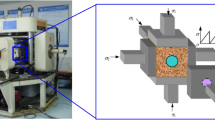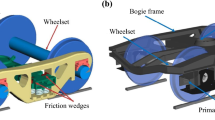Abstract
Skiing manufacturers depend on the development of new skis on trial and error cycles and extensive product testing. Simulation tools, such as the finite element method, might be able to reduce the number of required testing cycles. However, computer programs simulating a ski in the situation of a turn so far lack realistic ski–snow interaction models. The aim of this study was to (a) implement a finite element simulation of a ski in a carved turn with an experimentally validated ski–snow interaction model, and (b) comparison of the simulation results with instantaneous turn radii determined for an actual carved turn. A quasi-static approach was chosen in which the ski–snow interaction was implemented as a boundary condition on the running surface of the ski. A stepwise linear function was used to characterise the snow pressure resisting the penetration of the ski. In a carved turn the rear section of the ski interacts with the groove that forms in the snow. Two effects were incorporated in the simulation to model this situation: (a) the plasticity of the snow deformation, (b) the influence of the ski’s side-cut on the formation and shape of this groove. The simulation results agreed well with experiments characterising snow penetration. Implementation of the groove in the ski–snow interaction model allowed calculation of the instantaneous turn radii measured in actual turns, but also caused significant numerical instability. The simulation contributes to the understanding of the mechanical aspects of the ski–snow interaction in carved turns and can be used to evaluate new ski designs.








Similar content being viewed by others
References
Casolo F, Lorenzi V (2001) Science and skiing II. In: Müller E, Schwameder H, Raschner C, Lindinger S, Kornexl E (eds) Relevance of ski mechanical and geometrical properties in carving technique: a dynamic simulation. Verlag Dr. Kovac, Hamburg, pp 165–179
Glenne B, DeRocco A, Vandergrift J (1997) The modern alpine ski. Cold Reg Sci Technol 26:35–38
Howe J (2001) The new skiing mechanics. McIntire Publishing, Waterford
Abele G, Gow AJ (1976) Compressibility characteristics of compacted snow. CRREL Rep
Federolf P, Fauve M, Szabó D, Lüthi A, Rhyner HU, Schneebeli M, Ammann W, Dual J (2004) Mechanical properties of snow during rapid impact. Snow Eng V:209–214
Mössner M, Nachbauer W, Innerhofer N, Schretter H (2003) Mechanical properties of snow on ski slopes. In: Abstract book of the 15th international congress on ski trauma and skiing safety, St. Moritz Switzerland
Lieu DK, Mote CD (1984) Experiments in the machining of ice at negative rake angles, J. Glaciology 30:77–81
Tada N, Hirano Y (2002) Search of the mechanics of a turning alpine ski using snow cutting force measurements. Sports Eng 5:15–22
Brown CA (2009) Modeling edge-snow interactions using machining theory. In: Müller E, Lindinger S, Stöggl T (eds) Science and skiing, vol IV. Meyer & Meyer Sport (UK) Ltd., pp 175–183
Colbeck SC (1988) The kinetic friction of snow. J Glaciol 34:78–86
Colbeck SC (1994) A review of the friction of snow skis. J Sports Sci 12:285–295
Outwater JO (1970) On the friction of skis. Med Sci Sports 2:231–234
Buhl D, Fauve M, Rhyner H (2001) The kinetic friction of polyethylene on snow: The influence of the snow temperature and the load. Cold Reg Sci Technol 33:133–140
Theile T, Szabo D, Luthi A, Rhyner H, Schneebeli M (2009) Mechanics of the ski–snow contact. Tribol Lett 36:223–231
Nigg BM, Neukomm PA, Spirig J, Unold E (1975) Vibration measurements during skiing, gymnastics, walking and running. Medizinische Welt 26:765–770
Fischer C, Overney LS, Fauve M, Blanke O, Rhyner H, Herzog MH, Bourban P, Månson J-E (2007) What static and dynamic properties should slalom skis possess? Judgements by advanced and expert skiers. J Sports Sci 25:1567–1576
Bruck F, Lugner P, Schretter H (2003) A dynamic model for the performance of carving skis. ASTM special technical publication, pp 10–23
Casolo F, Lorenzi, V, Vallatta, A, Zappa B (1997) Simulation techniques applied to skiing mechanics. In: Müller E, Schwameder H, Kornexl E, Raschner C (eds) Science and skiing. Taylor & Francis, pp 116–130
Clerc C, Gaertner R, Trompette P (1989) Computer aided design of skis. Finite Elem Anal Des 5:1–14
Hirano Y, Tada N (1996) Numerical simulation of a turning alpine ski during recreational skiing. Med Sci Sports Exerc 28:1209–1213
Kaps P, Mössner M, Nachbauer W, Stenberg R (2000) Pressure distribution under a ski during carved turns. In: Proceedings of the 2nd international congress on skiing and science, pp 180–202
Piziali RL, Mote Jr. CD (1972) Snow ski as a dynamic system. ASME J Dyn Syst Meas Control Ser G 94:133–138
Renshaw AA, Mote CD Jr (1989) A model for the turning snow ski. Int J Mech Sci 31:721–736
Nordt AA, Springer GS, Kollár LP (1999) Simulation of a turn on alpine skis. Sports Eng 2:181–199
Tada N, Hirano Y (1999) Simulation of a turning ski using ice cutting data. Sports Eng 2:55–64
Mössner M, Heinrich D, Kaps P, Schretter H, Nachbauer W (2009) Computer simulation of consecutive ski turns. ASTM Special Technical Publication 1510 STP, pp 126–136
Federolf P (2005) Finite element simulation of a carving snow ski. Pro BUSINESS GmbH, Berlin
Mössner M, Heinrich D, Schindelwig K, Kaps P, Lugner P, Schmiedmayer H, Schretter H, Nachbauer W (2006) Modeling of the ski–snow contact for a carved turn. In: Moritz EF, Haake S (eds) The engineering of sport, vol 6. Springer, New York, pp 195–200
Numerical Modeling GmbH (2003) NM-SESES, Finite element software for computer aided engineering. Numerical Modeling GmbH. Winterthur, Switzerland
Graber C (1990) Nichtlineare Analyse von Schalen mit linearisierten elastoplastischen Schnittkraft-Verformungs-Beziehungen. Verlag der Fachvereine, Zurich, Switzerland
Wäckerlin J (1997) Numerische Modellierung von Rennskis.Thesis, Zurich University of Applied Sciences
Federolf P, JeanRichard F, Fauve M, Lüthi A, Rhyner H, Dual J (2006) Deformation of snow during a carved ski turn. Cold Reg Sci Technol 46:69–77
Müller E, Schwameder H (2003) Biomechanical aspects of new techniques in alpine skiing and ski-jumping. J Sports Sci 21:679–692
Jentschura UD, Fahrbach F (2004) Physics of skiing: the ideal-carving equation and its applications. Can J Phys 82:249–261
Lind D, Sanders SP (1996) The physics of skiing. Springer-Verlag New York Inc., New York
Tatsuno D, Yoneyama T, Kagawa H, Scott N, Osada K. (2009) Measurement of ski deflection and ski–snow contacting pressure in an actual ski turn on the snow surface. In: Müller E, Lindinger S, Stöggl T (eds): Science and Skiing vol IV. Meyer & Meyer Sport (UK) Ltd
Yoneyama T, Scott N, Kagawa H, Osada K (2008) Ski deflection measurement during skiing and estimation of ski direction and edge angle. Sports Engineering 11:3–10
Scott N, Yoneyama T, Kagawa H, Osada K (2007) Measurement of ski snow-pressure profiles. Sports Eng 10: 145–156
Glenne B, DeRocco A, Foss G (1999) Ski and snowboard vibration. Sound Vib 33:30–33
Ghoreishy MHR (2008) A state of the art review of the finite element modelling of rolling tyres. Ir Polym J (English Edition) 17:571–597
Shoop S, Kestler K, Haehnel R (2006) Finite element modeling of tires on snow. Tire Science and Technology 34:2–37
Acknowledgments
The study was financially supported by the Swiss Foundation for Innovation KTI and the companies Stöckli Swiss Sports AG and Fritschi Swiss Bindings.
Author information
Authors and Affiliations
Corresponding author
Rights and permissions
About this article
Cite this article
Federolf, P., Roos, M., Lüthi, A. et al. Finite element simulation of the ski–snow interaction of an alpine ski in a carved turn. Sports Eng 12, 123–133 (2010). https://doi.org/10.1007/s12283-010-0038-z
Published:
Issue Date:
DOI: https://doi.org/10.1007/s12283-010-0038-z




